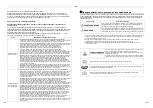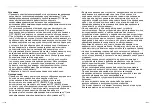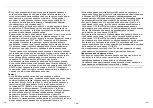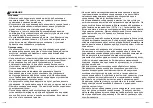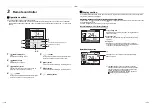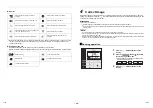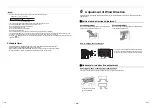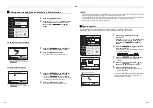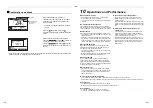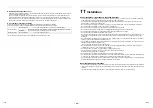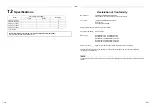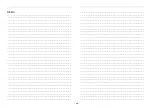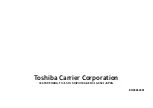
– 62 –
Replacing a refrigerant leak detection sensor
WARNING
If check codes “J29” or “J31” appear on the remote controller LCD (Liquid Crystal Display), replace a
refrigerant leak detection sensor. Contact the dealer where you purchased the air conditioner to replace
the refrigerant leak detection sensor. Continuing to use the air conditioner without replacing the sensor
may cause a fire in case refrigerant leak occurs.
Check code “J29” appears when the sensor trouble is detected.
Check code “J31” appears when the sensor is out of the life of the product.
Contact the dealer where you purchased the air conditioner to replace the refrigerant leak detection sensor.
● Check period and Maintenance period
Check period:
One year
Maintenance period:
Five years
(Replacement)
* Places where a lot of siloxanes are present (Hair salon) require periodic maintenance for sensor since there is a possibility
that refrigerant leak detection sensor won't be able to work.
9
Troubleshooting
Check the points described below before requesting repair.
If there is something unusual even after checking the above, stop running the unit, turn off the circuit breaker, and contact the
dealer where you purchased the product of the product number and symptom. Do not attempt to repair the unit by yourself as
doing so is dangerous. If the check code is displayed on the remote controller LCD, inform the dealer of its content as well.
If any of the following occur, stop running the unit immediately, turn off the circuit breaker, and contact the dealer where you
purchased the product.
• The switch does not work properly.
• The circuit breaker often blows out.
• You unintentionally put a foreign object or water inside.
• The unit cannot be run even after the cause of the protective device activation is removed.
• Other unusual conditions are found.
Symptom
Cause
It is
no
t a malfuncti
on
.
Outdoor unit
• White, misty, cold air or water comes out.
• Sometimes the noise of air leaking is heard.
• A noise is heard when the power is turned
on.
• The fan of the outdoor unit is automatically stopped and
defrosting is performed.
• The solenoid valve works when defrosting starts or stops.
• The outdoor unit is preparing for running.
Indoor unit
• Sometimes a swishing is heard.
• A clacking sound is heard.
• Discharged air smells unusual.
• When the unit starts running, during operation, or
immediately after the unit stops running, a sound such as
water flowing may be heard, or the operation sound may
become louder for a couple of minutes immediately after
the unit starts running. This is the sound of the refrigerant
flowing or the dehumidifier draining.
• This is a sound generated when the heat exchanger, etc.
expands and contracts slightly due to temperature
change.
• Various smells from the walls, carpet, clothes, cigarette,
cosmetics, etc. adhere to the air conditioner.
Check agai
n.
• The unit does not run
• Has a blackout occurred?
• Has the circuit breaker blown?
• Has the protective device been activated?
The room does not cool down or warm up.
• Is the air intake or discharge of the outdoor unit clogged?
• Is a door or window open?
• Is the air filter clogged with dust?
• Is the fan speed set to “Low”? Or is the operation mode
set to “Fan”?
• Is the setup temperature appropriate?
• A fan of the indoor unit does not stop even if
[
ON/OFF] button
is pushed.
• Check code “J30” appears on the remote controller LCD.
• Refrigerant may leak from the indoor unit. Do not turn off
the circuit breaker and ventilate the room, and then
contact the dealer where you purchased the product.
• Do not use gas equipment (propane, butane, or methane)
or sprays near indoor unit. Doing so may cause the
sensor to detect refrigerant leak mistakenly. Contact the
dealer where you purchased the product.
• Check code “J29” appears on the remote controller LCD.
• Refrigerant leak detection sensor is in trouble. Since the
sensor may need replacing, contact the dealer where you
purchased the product.
• Check code “J31” appears on the remote controller LCD.
• The refrigerant leak detection sensor exceeds the life of
the product. Contact the dealer where you purchased the
product to replace the sensor.
123-EN
124-EN


